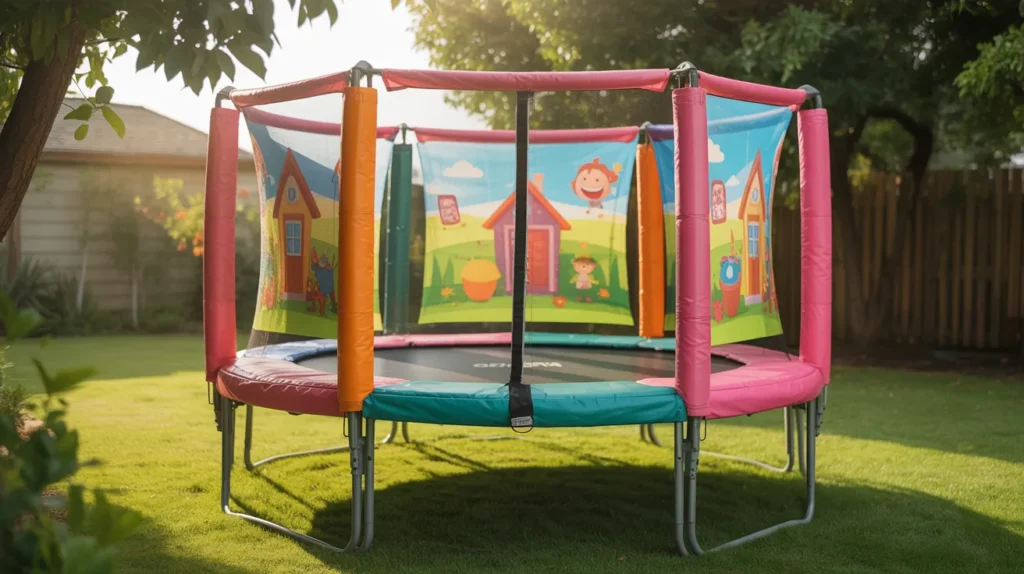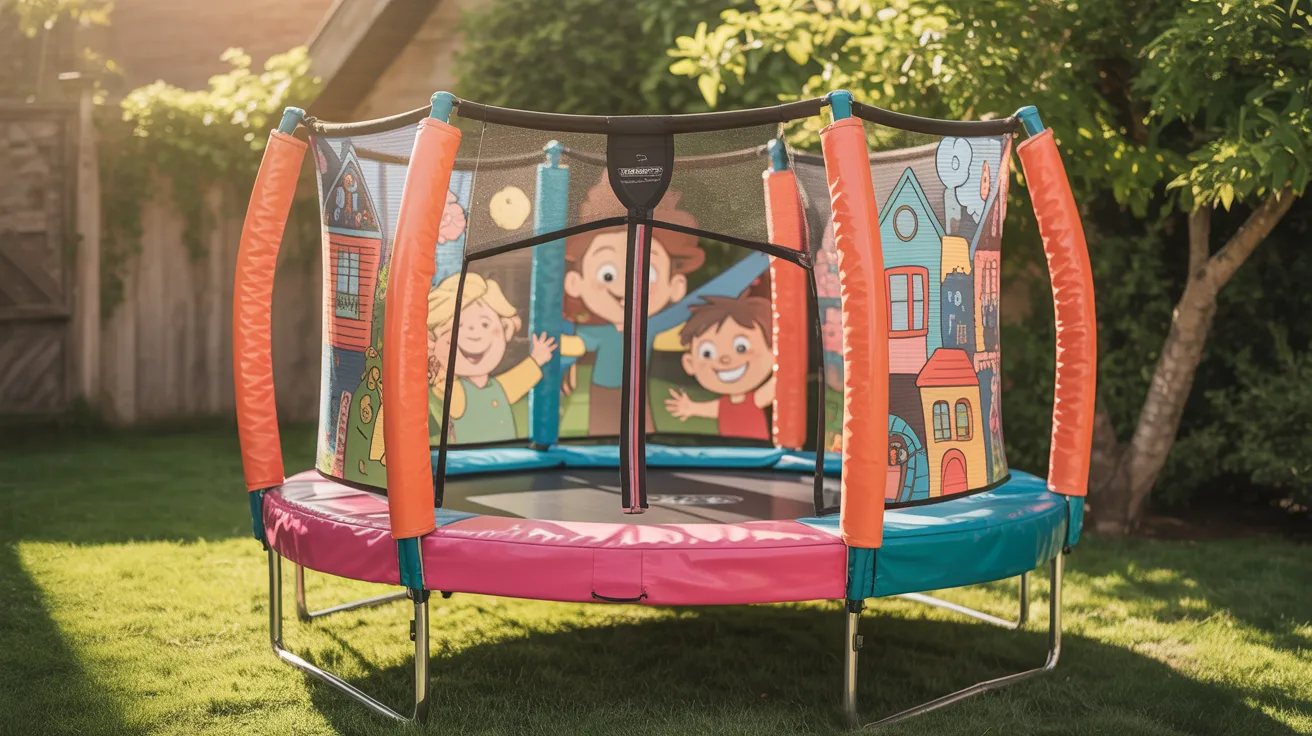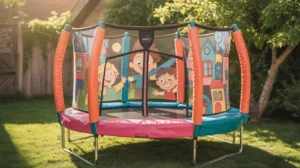Springing Into the World of Trampoline Humor 🤸
The Joy of Defying Gravity
Remember the first time you stepped onto a trampoline? That exhilarating mix of fear and excitement as your feet left solid ground? You discovered the pure joy of defying gravity!
Trampolines have been launching humans skyward since the 1930s. Gymnast George Nissen got the brilliant idea after watching trapeze artists land in safety nets. He called it a “trampoline” after the Spanish word “trampolín,” meaning diving board.
Trampolines Today
Today, over 3 million American households own trampolines. Backyard bouncing has become a childhood rite of passage. However, they cause approximately 100,000 emergency room visits annually—safety first, folks!
From Olympic-level gymnastics to suburban Saturday afternoons, trampolines represent unbridled fun. They inspire fitness trends like trampoline parks and professional competitions. And yes, they’ve created an endless supply of springy wordplay!
So strap in (or should I say, strap on those grippy socks?) as we bounce through the most elevated collection of trampoline humor you’ll find anywhere!
🎪 Classic Trampoline Puns: The Foundation of Bouncy Comedy
Why Trampolines Make Perfect Pun Material
Trampolines occupy a unique space in our collective consciousness. They’re simultaneously thrilling and slightly dangerous. They’re childlike yet athletic. They’re simple yet physics-defying.
The basic trampoline uses a taut fabric stretched over a steel frame. Coiled springs (or elastic bands in newer models) create the rebounding surface. This can launch a person 10-30 feet in the air!
The Science Behind the Bounce
Professional trampolinists (yes, that’s a real word!) can reach heights of 30 feet. They perform complex aerial maneuvers with names like “barani,” “rudolph,” and “kaboom.”
The physics involved would make Newton proud. Potential energy converts to kinetic energy with each bounce. But we’re not here for a science lesson. We’re here because trampolines have given us vocabulary rich with bouncing metaphors!
The Best Classic Trampoline Jokes
- I told my friend a trampoline joke, and they said “That really made my spirits bounce back!” Turns out laughter has great rebound potential.
- Why did the trampoline start a motivational speaking career? Because it knew how to help people reach new heights! Up and coming in the self-help industry.
- My trampoline and I have a great relationship because we always stay on the same wavelength—up and down! Synchronized bouncing builds strong bonds.
- The trampoline applied for a job but couldn’t stop jumping to conclusions during the interview process!
- Why don’t trampolines ever feel depressed? They always bounce back from setbacks! Resilience is literally built into their design.
- I asked my trampoline for life advice and it said, “Sometimes you have to hit rock bottom before you can spring back up!” Deeper wisdom than expected.
- The trampoline opened a therapy practice specializing in helping people get over their ups and downs—five-star reviews across the board!
- Why did the trampoline win the positivity award? It had an incredibly uplifting personality! Never met a more optimistic piece of equipment.
- My trampoline told me, “I’m just here to give you a spring in your step!” Literally and figuratively supportive.
- The philosophy professor asked the trampoline about existence, and it replied, “I think, therefore I bounce!” Descartes would be confused but impressed.
- Why do trampolines make terrible secret keepers? Because they can’t help but spring surprises on everyone! Discretion isn’t their strong suit.
- I tried having a serious conversation with my trampoline, but it kept making light of the situation by launching me skyward!
🏋️ Fitness & Exercise Trampoline Jokes: Workout Worthy Wit
The Rise of Rebounding
Trampoline fitness—or “rebounding” as enthusiasts call it—exploded in the 1980s. NASA published a study claiming rebounding was 68% more efficient than jogging. Later studies questioned these exact numbers. However, the exercise benefits remain legitimate!
Today, boutique fitness studios charge $30+ per class. It’s essentially organized bouncing set to club music. Mini trampolines, or rebounders, have invaded living rooms worldwide.
Why Rebounding Works
These workouts promise low-impact cardio that burns 200-300 calories in 30 minutes. They’re gentle on joints. The fitness industry embraced trampolining because it engages your core. It improves balance. It stimulates your lymphatic system.
Most importantly, it doesn’t feel like torture the way burpees do!
Read more: 101+ Van Jokes & Puns: You’ve Been Warned!
Olympic Trampolining
Olympic trampolining became an official sport in 2000. It combines athletic prowess with graceful aerial choreography. Whether you’re a fitness fanatic or not, trampoline workouts represent the rare intersection of effective and genuinely fun.
It’s proof that exercise doesn’t have to be miserable!
Fitness-Focused Trampoline Puns
- My fitness instructor said trampoline workouts would be fun, and I replied, “Well that’s a jump to conclusions I can support!” Finally, exercise that doesn’t make me cry.
- Why did the personal trainer recommend rebounding? Because it’s the only workout where falling down is actually part of the exercise! Revolutionary fitness philosophy right there.
- I joined a trampoline fitness class and learned my bounce game was weak but my enthusiasm was strong—effort counts, right?
- The gym’s trampoline section became most popular because people finally found their happy medium between working out and playing—childhood dreams realized!
- Why do trampoline workouts burn so many calories? Because fighting gravity is exhausting work, even when gravity keeps losing! Take that, Newton!
- My doctor recommended rebounding for lymphatic drainage, so now I’m basically a bounce-certified health professional—medical degree pending.
- The fitness influencer posted “Get your bounce on!” and I thought, “Finally, workout advice I can actually follow!” Where has this been all my life?
- Why did the athlete choose trampoline training? Because they wanted to elevate their game literally and figuratively! Double meaning, double gains.
- I told my couch potato friend about trampoline workouts and they said, “Sounds like a rebound relationship I can commit to!” Progress is progress.
- The rebounding class promised “low-impact, high-fun” and delivered on both while I questioned my coordination—humbling yet exhilarating!
- Why do kids love trampoline fitness? Because it’s the only time parents encourage jumping on furniture! Loopholes in household rules exploited successfully.
- My smart watch recorded my session as “unknown activity” because even technology can’t comprehend exercise that’s actually enjoyable—system error!

👨👩👧👦 Family Backyard Trampoline Humor: Suburban Springboard Stories
The Backyard Centerpiece
The backyard trampoline represents peak suburban living. It’s a statement piece that announces “we’re fun parents, but also slightly reckless!” to the entire neighborhood.
Statistics show trampolines increase property appeal for families with kids. However, they simultaneously increase homeowner’s insurance premiums. Life’s all about balance, folks!
The Great Safety Debate
The safety net debate divides communities. Some parents insist they’re essential. Others claim they create a false sense of security. This leads to more dangerous behavior, they argue.
Neighbor kids mysteriously appear whenever the trampoline emerges in spring. They’re like moths to a bouncing flame!
Universal Trampoline Rules
Every trampoline has its rules. Maximum capacity gets ignored. No shoes gets enforced sporadically. The universal “stop bouncing when someone’s trying to get on” regulation? No one ever follows it.
These backyard fixtures host birthday parties and summer afternoon time-killers. They create memories of scraped knees and epic bounce battles. At least one kid always cries because someone was “bouncing them too high.”
The backyard trampoline is where childhood happens!
Backyard Bouncing Jokes
- We installed a backyard trampoline and immediately became the most popular house on the block—social status achieved through bounce!
- Why do parents regret buying trampolines? Because suddenly you’re running a free amusement park for every neighborhood kid! The crowd never leaves.
- My kids argued over trampoline time until I said, “You need to learn to share or nobody bounces!” Solomon would be proud.
- The neighbor asked if their kids could use our trampoline and I said, “Sure, but sign this waiver first!” Half-joking, mostly serious.
- Why do backyard trampolines always have leaves in them? Because nature abhors a vacuum and loves a bounce surface! Cleaning is futile.
- My dad spent three hours assembling the trampoline while muttering, “This better be worth it or I’m returning this thing!” (It was worth it.)
- The trampoline became the neighborhood gathering spot where kids learned important life skills like taking turns—character building!
- Why did the HOA complain about our trampoline? Because apparently “excessive fun” violates community standards! Suburban warfare at its finest.
- We set a “three kids maximum” rule that everyone ignores, teaching me that capacity suggestions are more like guidelines—pirate code applies!
- My spouse said buying a trampoline would be an investment in family fun, and for once, an impulse purchase actually delivered—miracles happen!
- Why do trampolines look sad in winter? Because they’re covered in tarps, buried in snow, and desperately missing their purpose! Seasonal depression is real.
- The kids’ birthday party was chaos, proving organized bouncing is an oxymoron with eight sugar-fueled children involved—beautiful disaster!
Related: 99+ Trail Mix Puns & Jokes: A Hike-larious Snack Attack!
🚑 Trampoline Safety Jokes: Bouncing Responsibly (Sort Of)
The Elephant in the Emergency Room
Let’s address the bouncing elephant in the room. Trampoline injuries are no joke—except when we’re making jokes about them, which is now!
The American Academy of Pediatrics has long recommended against recreational trampoline use. They cite injury rates that would make a helicopter parent’s heart stop.
Common Trampoline Injuries
Common injuries include ankle sprains, fractures, and head injuries. The highest risk occurs when multiple people bounce simultaneously. This is something every trampoline owner swears they won’t allow. That lasts approximately five minutes after setup.
The infamous “double bounce” launches another person extra high. It’s simultaneously the most fun and dangerous trampoline activity ever invented.
Modern Safety Innovations
Modern safety innovations include padded springs and safety nets. They include ladder restrictions too. Yet injuries persist. Why? Because humans fundamentally struggle with impulse control when faced with a bouncing surface!
Professional trampolinists train for years to safely execute tricks. Meanwhile, backyard enthusiasts attempt backflips after one YouTube tutorial. The gap between confidence and competence has never been wider!
Safety-Themed Trampoline Puns
- The doctor asked how I injured myself and I said, “I attempted a flip I definitely wasn’t qualified for!” Confidence exceeded ability by a concerning margin.
- Why do safety nets exist on trampolines? Because humans repeatedly prove we need protection from our own terrible decisions! Darwin awards, narrowly avoided.
- My mom installed a safety net and said, “This is to keep you in, not to keep danger out!” She understood the assignment.
- The warning label listed 47 ways to injure yourself, making me realize trampolines come with more warnings than prescription medications—proceed with caution!
- Why do insurance companies hate trampolines? Because they’re statistically proven fun-but-risky investments that end in paperwork! Actuarial nightmares in backyard form.
- I read all the safety instructions before using the trampoline, becoming the first person in history to actually follow the guidelines—unicorn status!
- The emergency room nurse said, “Let me guess, trampoline?” before I even spoke, proving medical professionals have seen this movie before—many times!
- Why did the cautious parent remove the trampoline? Because they calculated the fun-to-potential-injury ratio and panicked! Risk assessment ruined everything.
- My friend attempted a backflip and learned that confidence doesn’t equal competence, especially mid-air—physics always wins!
- The safety video showed perfect form while I thought, “Nobody actually bounces like that in real life!” Unrealistic expectations established.
- Why do trampolines have weight limits? Because physics cares about math even when excited children don’t! Engineering meets reality, reality wins.
- I followed every safety rule and still hurt myself, teaching me that precaution can’t protect against pure clumsiness—some people shouldn’t bounce!
🎓 Physics & Science Trampoline Puns: Academically Bouncy
The Science of Spring
Trampolines are essentially physics experiments disguised as fun! The mechanics involve Hooke’s Law. Force equals spring constant times displacement.
They demonstrate conservation of energy. Potential converts to kinetic and back. They show projectile motion. What goes up must come down. Preferably on the trampoline and not the neighbor’s fence!
How Energy Conversion Works
When you land on a trampoline, your kinetic energy stretches the springs. This stores potential energy. That releases to launch you back up. It’s a continuous energy conversion cycle that would fascinate any physics teacher.
The springs’ coefficient determines bounce quality. Tighter springs mean firmer bounces. Looser springs provide softer landings.
Professional vs. Amateur Physics
Professional trampolines use specific spring configurations. They optimize height and control. Gravity acceleration (9.8 m/s²) remains constant. But the trampoline’s rebound force can overcome it temporarily.
Athletes calculate rotation timing, body positioning, and landing angles with mathematical precision. Meanwhile, backyard enthusiasts just jump and hope for the best. They accidentally demonstrate physics principles while trying not to land on their faces!
Science-Based Trampoline Jokes
- The physics teacher used trampolines to explain energy conservation, and students said, “Finally, science class we can get behind—or rather, beneath!” Educational entertainment achieved.
- Why do physicists love trampolines? Because they’re perpetual motion machines powered by human enthusiasm! Newton would approve, probably.
- I tried explaining Hooke’s Law while bouncing and realized it’s hard to sound smart when you’re breathlessly flying through the air—timing is everything!
- The science fair project about trampoline physics won first place, proving kids learn better when the lesson involves fun equipment—revolutionary pedagogy!
- Why does bouncing feel weightless at the peak? Because for one glorious moment, gravity gives up its hold! Brief victory over fundamental forces.
- My engineer friend calculated optimal bounce angles and I said, “Or we could just jump and see what happens!” Different approaches, same outcome.
- The trampoline demonstrates energy conversion so perfectly that it’s basically a physics textbook you can bounce on—finally, useful education!
- Why did the science student ace the test? They spent all semester conducting hands-on trampoline research! Studying never felt so good.
- I learned about projectile motion the hard way when I bounced too close to the edge and became a real-world example—practical application hurts!
- The gravitational force discussion got interesting when someone asked, “But why does the trampoline make us feel like flying?” Magic, disguised as physics!
- Why do trampolines make perfect teaching tools? Because abstract concepts become concrete when you’re experiencing them mid-bounce! Kinesthetic learning wins.
- My physics homework asked about energy systems and I wrote, “The trampoline is life: what you put in, you get out!” Got extra credit!
Related: 125+ Copenhagen Puns & Jokes: You’re in for a Treat!
🎬 Pop Culture Trampoline References: Bouncing Into Fame
Trampolines in the Spotlight
Trampolines have bounced their way through pop culture for decades! Remember the iconic Breaking Bad scene? Walt Jr. creates a donation website to save his dad. He uses a trampoline accident as the cover story.
Or The Office episode where Michael Scott purchases a trampoline for the office? That led to predictable disaster!
TV and Movie Moments
The Simpsons featured multiple trampoline injuries. This cemented their status as both fun and hazardous in our cultural consciousness.
Music videos frequently feature trampolines as symbols of carefree joy. Katy Perry’s “California Gurls” and Pharrell’s “Happy” both showcase bouncing humans radiating positivity.
YouTube and Social Media Fame
YouTube’s trampoline content ranges from professional acrobatics to fail compilations. These have millions of views. They prove humanity’s endless fascination with watching people defy (or succumb to) gravity.
Social media challenges like the #TrampolineChallenge went viral. People attempted increasingly complex tricks.
Celebrity Trampoline Owners
Celebrities admit to trampoline ownership. Justin Bieber, David Beckham, and Tom Cruise all reportedly have backyard trampolines. The trampoline has transcended mere recreational equipment. It’s become a cultural symbol of fun, freedom, and occasionally, medical emergencies!
Pop Culture Trampoline Puns
- Breaking Bad used a trampoline accident as a cover story, teaching viewers that believable lies involve common suburban injuries—criminal creativity!
- Why did The Office’s trampoline scene resonate? Because everyone knows someone who’d absolutely bring a trampoline to work! Michael Scott energy is universal.
- The Simpsons predicted trampoline injuries decades ago, proving the show’s prophecies extend beyond politics into backyard recreation—eerily accurate!
- Music videos feature trampolines because nothing says “carefree joy” like adults bouncing enthusiastically with no responsibilities—visual happiness shorthand!
- Why do YouTube trampoline fails go viral? Because schadenfreude is humanity’s guilty pleasure and gravity’s revenge is always entertaining! We watch, we share.
- Justin Bieber’s backyard trampoline posts made fans say, “Celebrities—they’re just like us, but with fancier safety nets!” Relatable yet aspirational.
- The #TrampolineChallenge went viral because social media loves watching people attempt athleticism they haven’t earned—entertainment value: priceless!
- Why do movie characters have dramatic conversations on trampolines? Because nothing says “serious moment” like gently bouncing during confessions! Directorial choices baffle me.
- Tom Cruise reportedly does his own trampoline stunts, which tracks because that man has no fear and questionable self-preservation instincts—brand consistency!
- The trampoline park scene in every teen movie exists because filmmakers know bouncing equals fun in audiences’ minds—lazy but effective!
- Why did trampolines become Instagram-worthy? Because aerial shots of people bouncing are aesthetically pleasing and engagement-driving! Algorithm-friendly content discovered.
- Pop culture elevated trampolines from equipment to symbols of freedom, joy, and occasionally poor decision-making—the full human experience!
🏆 Professional Trampoline Sports: Elite Bouncing Excellence
From Backyard to Olympics
Professional trampolining is wildly different from backyard bouncing. Imagine the gap between splashing in a pool and Olympic swimming. Then multiply it!
Olympic trampoline athletes perform routines consisting of ten contacts with the mat. They execute combinations of somersaults and twists while reaching heights of 25-30 feet.
How Judges Score Performances
Judges score based on execution, difficulty, time of flight, and horizontal displacement. The sport requires incredible body awareness and core strength. Athletes need years of training to master skills.
These have names like “Miller” (triple front somersault with a twist). Or “Triffis” (triple back somersault with one and a half twists).
International Competition
China dominates Olympic trampolining. However, Canada, Russia, and Britain consistently medal.
Trampoline gymnastics also includes synchronized trampolining. Two athletes perform identical routines simultaneously—coordination goals! Double mini-trampoline involves a smaller trampoline for tumbling passes.
The Professional Difference
Professional competitive trampolining is to your backyard trampoline what Formula 1 is to your morning commute. Technically the same activity. Completely different universes!
Elite Athlete Trampoline Jokes
- The Olympic trampolinist explained their training regimen and I realized my backyard bounce sessions don’t qualify as athletic preparation—shocking revelation!
- Why do professional trampolinists make it look easy? Because thousands of hours of practice create the illusion of effortless grace! Spoiler: it’s not effortless.
- I watched Olympic trampolining and thought, “I could totally do that!” (Narrator: They absolutely could not do that.)
- The synchronized trampoline team moved in perfect harmony, proving some people can coordinate while I can barely walk—genetic advantages exist!
- Why did trampolining become an Olympic sport? Because someone realized backyard fun could become elite competition with enough flips! Professionalizing play achieved.
- The professional said they train 30 hours weekly and I calculated that’s more time than I’ve spent bouncing in my entire life—dedication differential!
- My attempt at a double somersault taught me that confidence and competence are not interchangeable, especially mid-rotation—painful lesson learned!
- Why do trampoline athletes have such strong cores? Because defying gravity requires abdominal muscles that could deflect bullets! Fitness level: superhuman.
- The commentator described a “Randy” and I thought, “That’s not a skill, that’s a person’s name!” Trampoline terminology confuses me.
- I tried one professional trick and learned my insurance doesn’t cover “attempted Olympic-level athletics without training”—coverage gaps identified!
- Why does China dominate trampolining? Because they identified bouncing talent early and trained it relentlessly for decades! Strategic national programs work.
- The professional’s Instagram shows flawless aerial photography, while mine shows me barely completing one flip looking terrified—skill gap documented!
Read more: 109+ Hot Air Balloon Jokes & Puns: You’ll Float Away!
🎉 Trampoline Park Adventures: Commercial Bouncing Bonanzas
The Indoor Bounce Revolution
Trampoline parks exploded in popularity during the 2010s. They transformed warehouses into wall-to-wall bouncing playgrounds.
These commercial facilities feature interconnected trampolines. They have foam pits, dodgeball courts, and basketball hoops at jump-accessible heights. Obstacle courses design themselves to exhaust children and adults alike.
The Business of Bouncing
Sky Zone launched in 2004 and pioneered the concept. It sparked an industry now worth over $1 billion globally.
Trampoline parks charge $15-25 per hour. This makes them pricier than movie tickets but cheaper than therapy. They’re arguably more effective at burning off energy!
The Social Hub
They’ve become default birthday party venues. They’re corporate team-building locations. They’re date spots for couples who think regular dinner is boring.
Safety concerns mirror backyard trampolines but amplified. More people means more chaos. That means more potential for collision-based injuries.
The Commercial Experience
Most parks require grippy socks (sold separately, naturally). They require signed waivers acknowledging you understand the risks.
Despite the dangers, or perhaps because of them, trampoline parks represent pure fun. They make you feel like a kid again. Until the next morning when your muscles remind you that you’re definitely not a kid anymore!
Trampoline Park Comedy
- I visited a trampoline park and realized childhood nostalgia costs $22 per hour plus mandatory sock purchases—capitalism monetized my memories!
- Why do trampoline parks require waivers? Because acknowledging danger before you injure yourself is legally protective! Sign away your right to sue for fun!
- The birthday party featured 12 kids hopped up on cake, zero adult supervision, and predictable chaos—Lord of the Flies with trampolines!
- My friend challenged me to trampoline park dodgeball and I learned that adding bouncing to any sport multiplies difficulty by ten—humbling experience!
- Why do adults love trampoline parks? Because for 60 minutes we can pretend responsibilities don’t exist while we bounce irresponsibly! Adult recess restored.
- The foam pit looked inviting until I jumped in and realized getting out requires athletic ability I stopped having around 2003—stuck indefinitely!
- Trampoline park basketball made me feel like an NBA player until I airballed three shots despite being eight feet from the hoop—delusion shattered!
- Why do trampoline parks sell grippy socks? Because regular socks plus trampolines equals lawsuits they’d rather prevent! Safety through mandatory purchases.
- I attended corporate team-building at a trampoline park where coworker dynamics shifted based on who could do flips—unexpected hierarchy established!
- The obstacle course destroyed my ego and my knees, teaching me that confidence can’t overcome a complete lack of core strength—reality bites!
- Why do kids never want to leave trampoline parks? Because unlimited bouncing is the closest thing to actual magic in suburban life! Can’t blame them.
- My fitness tracker recorded trampoline park time as “extreme cardio” and I thought, “Finally, validation for fun masquerading as exercise!” Quantified approval!
🌟 Trampoline Metaphors: Life Lessons from Bouncing
Philosophy on Springs
Trampolines offer surprisingly profound metaphors for life! “Bounce back” has become shorthand for resilience. It’s the ability to recover from setbacks. Much like how the trampoline surface returns to form after compression.
Life coaches and motivational speakers love trampoline metaphors. “What brings you down can also launch you higher” applies to both physics and personal growth.
Spring in Your Step
The concept of “spring” in your step suggests vitality and energy. It’s directly borrowed from trampoline mechanics!
Therapists use rebounding as a metaphor for healthy emotional responses to trauma. You absorb the impact, process it, and return to equilibrium.
Business and Beyond
Business consultants discuss “bounce rate.” The term is borrowed from trampolines via websites. They use it to measure engagement.
Even the phrase “jumping to conclusions” takes on new meaning. This happens when you’ve literally jumped on a trampoline and misjudged the landing!
Related: 101+ Moving Jokes & Puns: You’re Gonna LOL!
Deep Lessons from Bouncing
These bouncing life lessons remind us that setbacks are temporary. Proper support systems (like springs and safety nets) matter. Sometimes you need to bend before you can rise.
Deep thoughts from backyard equipment!
Metaphorical Trampoline Puns
- My therapist used trampolines as a resilience metaphor, and I replied, “So I should bounce back from problems repeatedly until exhaustion?” Maybe the metaphor has limits!
- Why do life coaches love trampoline analogies? Because bouncing back sounds more inspirational than “try again after you fail!” Rebranding setbacks as springboards.
- The motivational poster showed a trampoline with text reading, “Fall down seven times, bounce back eight!” Math seems questionable but spirit is admirable!
- My friend said life’s challenges are like trampoline springs, and I thought, “That’s either profound or nonsense, can’t decide!”
- Why does “spring in your step” mean happiness? Because bouncing energy visually communicates joy better than plodding! Body language borrows from trampolines.
- The self-help book titled “The Trampoline Effect” promised how setbacks become launching pads for success—Amazon reviews mixed!
- I told my pessimistic friend to bounce back and they said, “I’m more of a permanent deflation type!” Not everyone’s a trampoline person.
- Why do people say “don’t let life keep you down”? Because the trampoline of existence is supposed to lift us back up! Persistent optimism or delusion?
- The business consultant explained market rebounds using trampoline physics, making me realize economists will metaphor anything for clarity—creative pedagogy!
- My grandmother said, “Life’s a trampoline—keep bouncing!” and I thought, “Grandma just gave better advice than my life coach!”
- Why do trampoline metaphors resonate? Because everyone’s experienced bouncing and can relate the physical to the emotional! Universal experiences make powerful analogies.
- The philosopher pondered trampolines and concluded, “We’re all just bouncing through existence, one jump at a time!” Either deep wisdom or oxygen deprivation!
🎪 Trampoline Tricks & Fails: The Good, The Bad, The Hilarious
When Ambition Exceeds Ability
YouTube’s trampoline content divides neatly into two categories. Incredible professional athleticism and hilarious amateur disasters. The gap between these categories is where comedy lives!
Common backyard tricks include seat drops (landing on your bottom). Front flips have a 50/50 success rate. Back flips are usually catastrophic for amateurs.
The Dangerous Double Bounce
Then there’s the ambitious double bounce. This coordinates two people’s jumps to launch one person extra high. What could go wrong? Spoiler: everything!
Professional tricks have specific names. Barani means front somersault with half twist. Rudolph means double front with one-and-a-half twists. The legendary quadruple back somersault? Maybe five people globally have attempted it.
Amateur Innovation
Meanwhile, backyard enthusiasts invent their own moves. They have names like “the failed flip.” Or “the accidental knee to face.” Or “that thing where you bounce off.”
Fail compilations rack up millions of views. Why? Because humanity loves watching others learn physics lessons the hard way!
The Universal Truth
The common thread? Trampolines humble everyone eventually. Physics doesn’t care about your confidence level. Gravity always collects its debts!
Trick and Fail Trampoline Jokes
- I attempted my first backflip and discovered that rotation speed and landing location are inversely related to my planning! Unexpected outcomes achieved painfully.
- Why do trampoline fail videos go viral? Because watching strangers experience gravity’s revenge satisfies something primal in us! Schadenfreude is universal entertainment.
- My cousin’s “signature move” involved bouncing high and screaming, which isn’t technically a trick but definitely made an impression—creativity over execution!
- The YouTube tutorial made backflips look easy until I tried one and learned video editing removes the failures, fear, and regret—deceptive media!
- Why do double bounces end badly? Because coordinating with another human requires communication skills nobody uses while bouncing! Chaos theory in action.
- I mastered the seat drop and felt accomplished until I watched a professional do a quadruple somersault and reassessed “mastery”—perspective gained!
- The neighborhood kids invented “the pretzel” which involved tangling limbs mid-air and hoping for the best—innovative yet medically questionable!
- Why do adults attempt tricks they last did at age ten? Because nostalgia erases memories of our former abilities and current limitations! Dangerous optimism!
- My “flawless” front flip on camera revealed multiple flaws when reviewed in slow motion—technology destroyed my self-perception!
- The tutorial warned “don’t try this at home” while showing a home trampoline, creating logical inconsistency that everyone ignored—advice is optional!
- Why do people film trampoline attempts? Because if you’re going to fail spectacularly, you might as well document it for posterity! Evidence-based humiliation!
- I tried the “barani” and created “the confused flail,” proving that naming your failure doesn’t make it success—linguistic gymnastics attempted!
🎯 Trampoline Shopping & Maintenance: The Practical Side of Bouncing
Investing in Bounce Infrastructure
Buying a trampoline involves more decisions than buying a car! Size matters significantly. Eight-foot trampolines suit small yards and single users. Twelve-foot models accommodate families. Fifteen-foot behemoths dominate entire backyards.
Shape affects bounce quality too. Round trampolines direct jumpers to the center (safer). Rectangular ones provide more consistent bounce across the surface. Athletes prefer these.
Technical Specifications
Spring count ranges from 72 to 96+. More springs generally mean better bounce quality. Budget ranges from $200 basic models to $2,000+ professional-grade equipment.
Safety features include padded spring covers. They include safety nets and ladder locks too.
The Assembly Challenge
Then comes assembly. This process tests marriages. It requires mechanical skills most people overestimate.
Maintenance includes spring cleaning (literally). You’ll check for rust. You’ll replace torn jump mats. You’ll battle the eternal war against leaves accumulating on the surface.
Storage Debates
Winter storage debates rage on. Should you leave it up? Take it down? Compromise with a weather cover?
Like any major purchase, trampolines require research, investment, and commitment to upkeep. But the bouncing joy justifies the hassle!
Shopping and Maintenance Humor
- We debated trampoline sizes for weeks until my spouse said, “Just buy the biggest one—we’ll move if we have to!” Priorities properly established.
- Why does trampoline assembly destroy relationships? Because the instruction manual uses hieroglyphics and assumes you have eight hands! Furniture assembly’s evil cousin.
- I bought a budget trampoline and learned that “you get what you pay for” applies painfully to recreational equipment—penny wise, bounce foolish!
- The salesperson said this model was “professional grade” and I replied, “Professional at what, causing buyer’s remorse?” Marketing language decoded!
- Why do replacement parts cost almost as much as new trampolines? Because manufacturers understand the sunk cost fallacy and exploit it masterfully! Economic psychology in action.
- My trampoline spring cleaning revealed an ecosystem of lost toys, leaves, and mysterious objects I can’t identify—archaeological discovery!
- The winter storage debate rivals political discussions, with strong opinions about whether trampolines can survive winter exposed—meteorological disagreement!
- Why do safety nets tear at the worst times? Because quality control is inversely proportional to how much you need the equipment working! Murphy’s Law!
- I spent three hours reading trampoline reviews and emerged more confused than when I started—analysis paralysis through consumer research!
- The weather cover promised to protect my trampoline but turned into a leaf-collecting water balloon by November—false advertising suspected!
Why does rust happen immediately after purchase? Because trampolines age in dog years—seven years of wear per actual year! Accelerated depreciation observed.
My friend bought a used trampoline and said, “It’s pre-broken-in!” Optimism or delusion? The springs will reveal the truth eventually!
Read more: 119+ Boot Jokes & Puns: You’ll “Kick” Yourself for Missing These!









